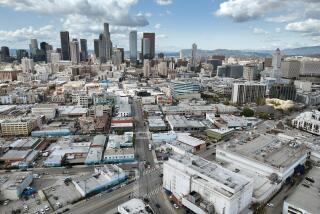We Want It Bigger, Better and With an Attitude
- Share via
So far nobody--except perhaps the designers--seems particularly pleased by the six proposals for rebuilding Lower Manhattan.
The plans were unveiled last week in anticipation of the one-year anniversary of the Sept. 11 terrorist attacks. Organizers had hoped to announce by now the designs for several smaller buildings and possibly a park on the site where the World Trade Center stood, but the half-dozen sketches on the table have elicited so many boos and Bronx cheers from scoffing Gothamites that the project’s overseers were forced to slink back to the drawing board in demi-disgrace.
For the record:
12:00 a.m. July 26, 2002 For The Record
Los Angeles Times Friday July 26, 2002 Home Edition California Part B Page 15 Editorial Pages Desk 1 inches; 41 words Type of Material: Correction
Lyrics about New York--In a column Thursday by Norah Vincent, the description of New York as a “wonderful town” was incorrectly attributed to composer Leonard Bernstein. Those lyrics were written by Betty Comden and Adolph Green.
It’s a little embarrassing, actually. Some of the wittier 5,000 New York City residents who were assembled at the Jacob K. Javits Convention Center last week to offer comments and suggestions about the project rightly quipped that, if realized, any of the feeble proposed designs would make downtown look like Albany--an insult whose asperity you probably have to be a New Yorker to fully appreciate. And it’s true. The offered designs are diminutive and cowering, lackluster and formulaic, not worthy of the Big Apple, not fitting additions to its once awesome, now rendingly diminished, skyline.
Size matters. So does panache. We need buildings with attitude. Nothing else will do, and it’s not just because we care about how our ragged gash of cityscape looks as you’re coming over the Triborough or the Brooklyn or the Queensboro Bridge. It’s because it matters how the sight of it makes us feel about what Leonard Bernstein called our wonderful town.
For native New Yorkers and pilgrims alike, there have been few things more heartbreaking about the protracted aftermath of Sept. 11 than the garish gap in the city’s famous profile, that blank, vacuous space on the horizon where the World Trade Center once so impressively stood.
Healing our pain will take more than plastering up some nondescript heap of pedestrian office space that meets the required quota of square footage but wouldn’t even inspire a flock of pigeons to deface it.
Our dead, as much as we honor and ache for them, do not need a valedictory park, or another Vietnam Memorial for tourists to sniffle and gawk at. Survivors of those who died, to whose suffering we are little more than absurd spectators, deserve a tasteful, sublime and enduring testament to their loss. We, the living, must move forward with our heads held high, not hanging in fetishized grief. We cannot stand any longer, as some of us have done, like overgrown children amid the ruins of our sandcastle, beating our foreheads first in naive disbelief, now in victimized self-satisfaction. Neither is a becoming posture to pin a monument on.
Are we what our enemies would have us be: Sodom on its knees? Or are we the vibrant, thriving capital of the free world, the untoppled colossus of culture and commerce that has inspired poets, novelists, composers, filmmakers and creative minds of every calling to enshrine our greatest city in their art for some 200 years?
“And Thee, across the harbor, silver-paced / As though the sun took step of thee, yet left / Some motion ever unspent in thy stride, -- / Implicitly thy freedom staying thee!”
The American poet Hart Crane wrote those words about the Brooklyn Bridge, and they should apply to whatever we plant at ground zero. Those who died there would, no doubt, have wanted it that way. Anything less would be a disservice to their memory.
More to Read
The biggest entertainment stories
Get our big stories about Hollywood, film, television, music, arts, culture and more right in your inbox as soon as they publish.
You may occasionally receive promotional content from the Los Angeles Times.










